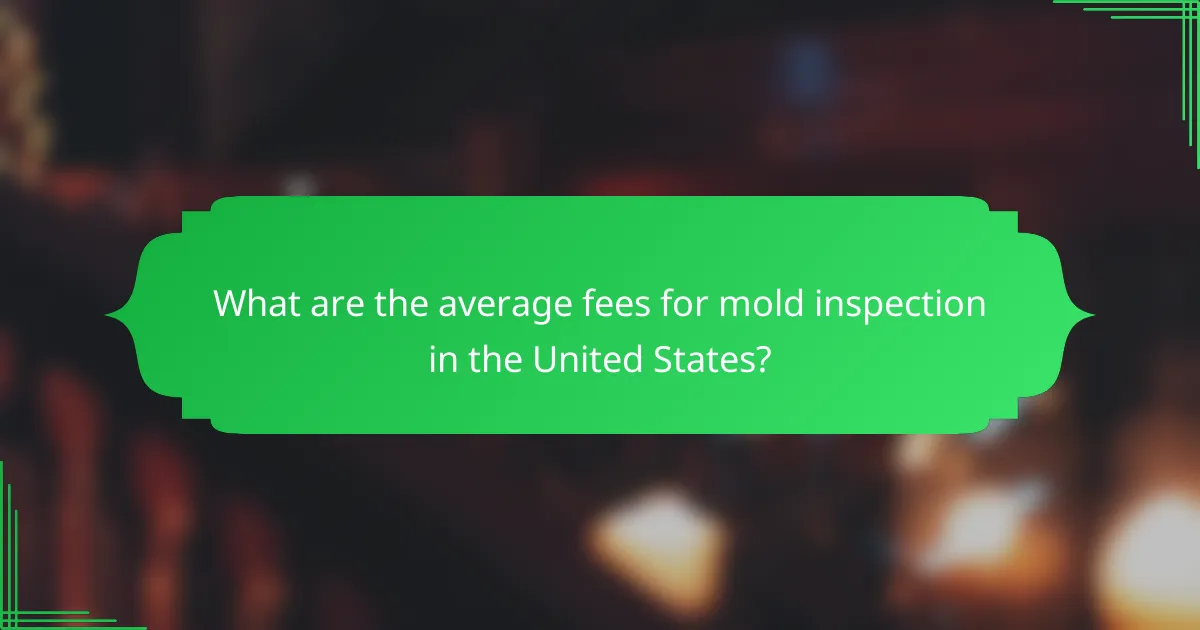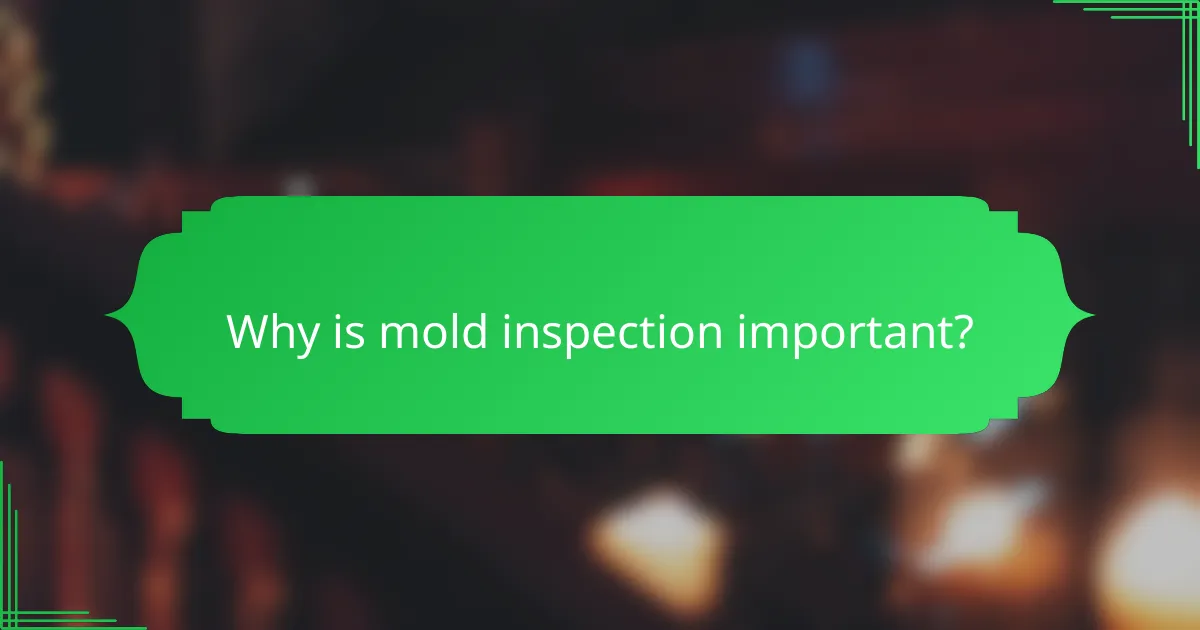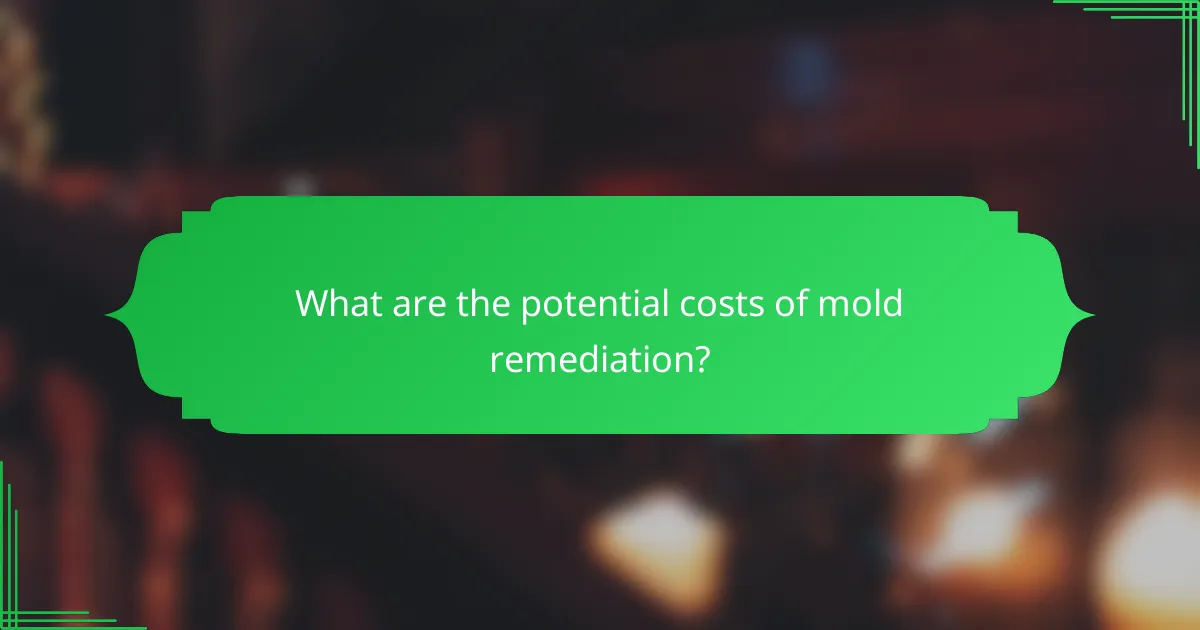Mold inspection is an essential step in maintaining a healthy living environment, with average fees in the United States ranging from $300 to $600. This investment is crucial for identifying mold growth early, preventing potential health risks and costly remediation efforts that can escalate into thousands of dollars. Regular inspections not only safeguard your property but also ensure peace of mind for homeowners.

What are the average fees for mold inspection in the United States?
The average fees for mold inspection in the United States typically range from $300 to $600. This cost can vary based on several factors, including the size of the property and the complexity of the inspection process.
Typical inspection costs
Most mold inspections are priced between $300 and $500 for standard residential properties. This fee usually covers a thorough visual inspection, moisture assessment, and basic air quality testing. Additional testing, such as surface sampling or laboratory analysis, may incur extra charges.
Factors influencing fees
Several factors can influence the fees for mold inspection. The size of the property plays a significant role; larger homes may require more time and resources, leading to higher costs. The inspector’s experience and the specific services offered, such as detailed reporting or follow-up consultations, can also affect the final price.
Additionally, the presence of visible mold or water damage may necessitate more extensive testing, which can increase the overall cost. It’s advisable to clarify what services are included in the quoted fee before proceeding with an inspection.
Regional price variations
Prices for mold inspection can vary significantly across different regions in the United States. For instance, urban areas or regions with higher living costs may see fees on the upper end of the average range. Conversely, rural areas may offer lower rates due to reduced demand and competition.
It’s beneficial to research local mold inspection companies and compare their pricing structures. Some states may also have specific regulations or standards that could influence inspection costs, so it’s wise to be aware of local guidelines.

Why is mold inspection important?
Mold inspection is crucial for identifying and addressing mold growth in homes and buildings before it leads to significant health and structural issues. Regular inspections help ensure a safe living environment and can save property owners from costly remediation efforts later on.
Health risks associated with mold
Mold can pose serious health risks, particularly for individuals with respiratory conditions, allergies, or weakened immune systems. Exposure to mold spores may lead to symptoms such as coughing, sneezing, skin irritation, and in severe cases, respiratory infections.
Children and the elderly are particularly vulnerable to the effects of mold exposure. It’s essential to address mold issues promptly to protect the health of all occupants in a property.
Preventing property damage
Ignoring mold growth can lead to extensive property damage, including compromised structural integrity and costly repairs. Mold can weaken wood, drywall, and other building materials, leading to potential safety hazards.
Regular inspections can help identify mold early, allowing for timely remediation that minimizes damage and repair costs. Property owners should consider scheduling inspections annually or after significant water damage events.
Insurance implications
Many insurance policies have specific clauses regarding mold damage, which can affect coverage. Some policies may cover mold remediation if it results from a covered peril, while others may exclude mold-related claims altogether.
Understanding your insurance policy and discussing mold coverage with your provider is crucial. Regular inspections and prompt remediation can also help maintain eligibility for insurance claims related to mold damage.

What are the potential costs of mold remediation?
The costs of mold remediation can vary significantly based on several factors, including the extent of the infestation and the methods used for removal. Generally, homeowners can expect to pay anywhere from a few hundred to several thousand dollars for effective remediation services.
Average remediation costs
The average cost for mold remediation typically ranges from $500 to $6,000, depending on the severity of the problem. Minor mold issues may be addressed for as little as $500, while extensive infestations requiring major repairs can exceed $5,000. It’s essential to get multiple quotes from certified professionals to ensure a fair price.
Factors affecting remediation expenses
Additionally, the location of the property can affect pricing. Urban areas may have higher labor costs compared to rural regions. It’s also important to consider whether the remediation service includes post-remediation testing, which can add to the total cost.
Cost comparisons by severity

How to choose a mold inspection service?
Selecting a mold inspection service involves evaluating their qualifications, experience, and the methods they use. It’s crucial to choose a reputable inspector to ensure accurate assessments and effective remediation recommendations.
Key selection criteria
When choosing a mold inspection service, consider their certifications and experience in the field. Look for inspectors who are certified by recognized organizations, such as the Institute of Inspection, Cleaning and Restoration Certification (IICRC) or the National Association of Mold Professionals (NAMP).
Additionally, assess their inspection methods. A thorough inspection should include visual assessments, moisture readings, and air quality testing. Services that offer comprehensive evaluations are more likely to provide reliable results.
Questions to ask inspectors
Before hiring a mold inspector, ask about their experience and the specific techniques they use during inspections. Inquire about the types of equipment they employ, as advanced tools can lead to more accurate findings.
It’s also essential to discuss the inspection process and what you can expect in terms of reporting. A detailed report should outline findings, potential health risks, and recommendations for remediation. Ensure that the inspector is willing to answer your questions and provide clarity on their findings.

What are the long-term benefits of mold inspection?
Mold inspection offers significant long-term benefits by identifying potential mold issues early, which can lead to healthier living environments and cost savings. Regular inspections help prevent extensive damage and costly remediation efforts down the line.
Improved indoor air quality
One of the primary benefits of mold inspection is the enhancement of indoor air quality. Mold spores can circulate in the air, leading to respiratory issues and allergies. By detecting and addressing mold problems promptly, homeowners can ensure a healthier atmosphere for their families.
Regular inspections can help identify hidden mold sources, such as behind walls or under carpets, which may not be visible during routine cleaning. This proactive approach minimizes the risk of airborne contaminants that can affect health.
Increased property value
Investing in mold inspection can lead to increased property value. Homes that are free from mold issues are more attractive to potential buyers, as they represent a lower risk for future problems. A clean mold report can serve as a strong selling point during real estate transactions.
Moreover, properties with documented mold inspections may command higher prices in the market. Buyers often prefer homes with a history of maintenance and care, which includes regular mold assessments.
Preventative maintenance advantages
Mold inspections play a crucial role in preventative maintenance, allowing homeowners to address issues before they escalate. Identifying moisture problems early can prevent mold growth, saving time and money on extensive repairs later.
Establishing a routine inspection schedule, such as annually or biannually, can help maintain a mold-free environment. This practice not only protects the property but also fosters peace of mind for homeowners, knowing they are taking proactive steps to safeguard their investment.
